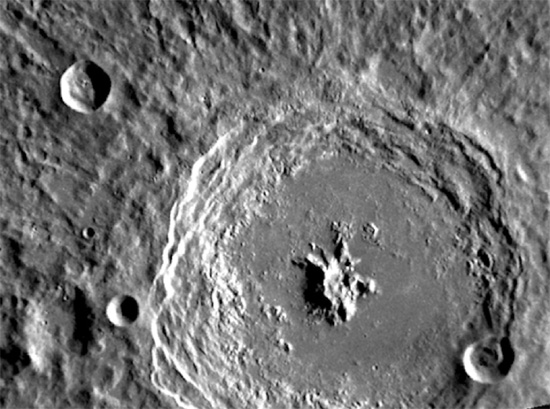|

Bartok crater on Mercury. Credit: NASA/Johns
Hopkins University
Applied Physics Laboratory/Carnegie Institution
of Washington
Son of Zeus
May 23, 2011
MESSENGER has completed 100
orbits around the planet Mercury.
In the image at the top of the page,
all the characteristics of an
electric discharge leaping from
Mercury's surface to space can be
seen. The crater walls are terraced,
there is a peculiar spiral-shaped
crater on the southeastern rim, and
several ridges converge onto the
central peak. Bartok's floor is also
flat and smooth for the most part,
one of the signs that point to a
plasma event of some kind in
Mercury's history.
In order to construct a new
theory of planetary evolution, it is
necessary to first assume different
engines of transformation and a
rapid morphology. Electric Universe
physicists couch their theories in
assumptions that do not conform to
the "long slow change" required by
conventional ideas of planetary
formation. Clearly, catastrophic
evolution cannot be merged with
gradualism. If the Solar System is a
four-billion-year-old antique, then
there is no way for a hypothesis
that calls for recent restructuring
to coexist. A new way of seeing the
Universe must first be adopted.
Many of the features on Mercury
are similar to those found on
Mars, as well as the
Moon.
Bright rays extend outward from
several large craters on Mercury,
similar to those seen around Tycho
Crater on the Moon. However, based
on an analysis of Tycho crater by
the late
Ralph Juergens, it is
more likely that the rays formed
when material suddenly rushed toward
the middle of the crater. A powerful
electric current pulled loose rocks
and dust inward into the center of
an active region where bolts of
electricity discharged upward. This
conclusion is diametrically opposed
to consensus opinions about "ejecta
ray" formation.
Another unusual structure in the
image of Bartok crater is the
hexagon located to the Northwest.
Nearly every
rocky object in the Solar
System exhibits similar structures.
How can the impact of a space rock
cause a hexagonal crater? No
experiment can create a polygonal
shape after an explosive event. No,
as pointed-out in several previous
Picture of the Day articles,
hexagons are created when intense
particle beams touch down on a solid
surface.
Electric arcs are composed of
Birkeland current filaments.
Researchers studying the issue have
found that beams of electricity
flowing through plasma create a
central column surrounded by
concentric cylinders. The
cylindrical discharge can sometimes
form
diocotron instabilities
in the vortex, forcing a hexagonal
shape. As the filaments rotate
around one another, a hexagonal
cross-section forms within the
innermost column.
Another example of electrical
effects on Mercury are the
etched furrows radiating
outward from some craters. Earlier
images of Caloris Basin show the
same kind of etching. In 2007, Dr.
C. J. Ransom performed an experiment
at Vemasat Laboratories in Fort
Worth, Texas. He exposed a thin
layer of magnesium silicate to a 120
milliamp, 12,000 volt discharge for
five-seconds. In that short period,
he produced
radial gouges in the
substrate similar to what has been
found on Mercury. Dr. Ransom's
experiments serve to demonstrate the
scalability of electrical activity.
Concentric structures are
found on Mercury. When
electricity passed through them it
eroded material from the surface
where the arc touched down because
the pits and craters left by
electric arcs are usually circular.
An electric arc is composed of two
(or more) filaments rotating around
a common center, so the surface was
excavated by a plasma "drill bit,"
leaving steep sides and a “pinched
up” rim of debris. If several
filaments were involved, the plasma
beams would have cut one crater
within another, often with one or
more smaller craters on the rims.
After traveling nearly eight
billion kilometers, the MESSENGER
spacecraft settled into orbit around
Mercury on March 17, 2011 and began
its scientific mission on March 23.
It is apparent that more information
from the innermost planet will
continue to confirm Electric
Universe theories of Solar System
dynamics.
Stephen Smith
 New
DVD New
DVD
The Lightning-Scarred
Planet Mars
A video documentary that could
change everything you thought you
knew about ancient times and
symbols. In this second episode of
Symbols of an Alien Sky, David
Talbott takes the viewer on an
odyssey across the surface of Mars.
Exploring feature after feature of
the planet, he finds that only
electric arcs could produce the
observed patterns. The high
resolution images reveal massive
channels and gouges, great mounds,
and crater chains, none finding an
explanation in traditional geology,
but all matching the scars from
electric discharge experiments in
the laboratory. (Approximately 85
minutes)
Video Selections
Order Link
|





 New
DVD
New
DVD

